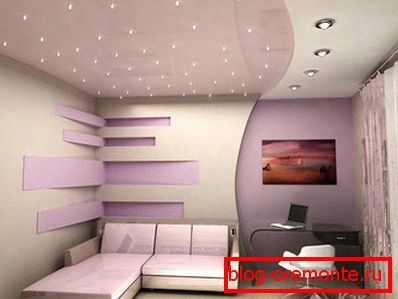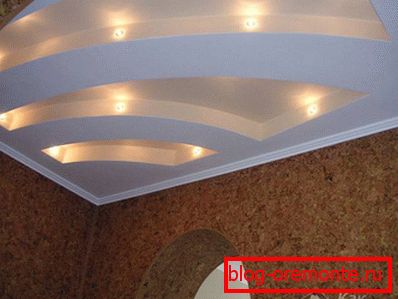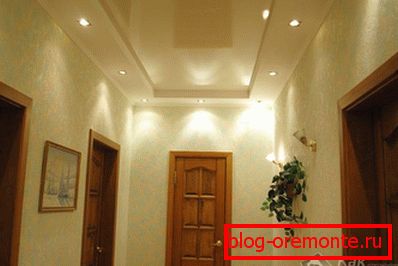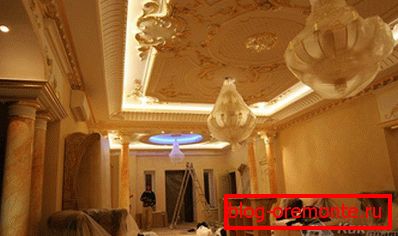Led ceiling lights do it yourself
The rapid development of new lighting technologies has led to the emergence of original techniques that allow you to completely change the visual perception of the volume of living spaces. You can transform your home today by updating the room lighting system by organizing LED ceiling lighting with your own hands. In our time, LED devices (so-called LED emitters) of the following known classes are used to illuminate living rooms:
- LED lamps of linear type;
- spotlights;
- LED strip with controllers;
- LED emitters floodlight type.
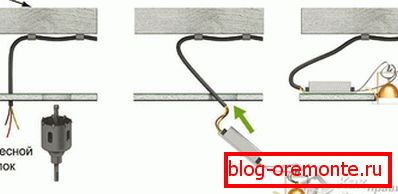
First-class illuminators are used, as a rule, in cases when it is necessary to organize the lighting of the linear portions of the rooms (dead walls or hidden from direct perception of sub-ceiling areas). LED devices of the second type are mounted so that the lamp body is recessed into the wall or ceiling, and only the front part with the radiator is visible on their surface. Due to the low temperature of the working areas of these lamps, they can be freely placed both on stretch-type ceilings and in special plastic or wooden decorative structures.
LED lighting of room ceilings in the apartment can be organized with the help of directional lights (like floodlights), placed on the walls of the room. These lamps are usually produced in color (RGB) or white versions and have good protection from moisture and dust.
Special LED strips (in conjunction with the controllers) are designed to obtain color dynamic effects with an arbitrary combination of colors in the RGB palette.
Development of the project backlight
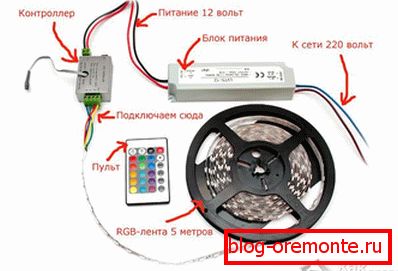
The development of a domestic project that allows you to organize your own LED ceiling lighting includes a number of the following preparatory plan operations:
- selection of LED illuminator model;
- counting the number of required fixtures (the length of the belt lights);
- selection of the optimal scheme of switching on luminaries and ribbons;
- installation of all elements of the backlight.

For rooms with a usable area of up to 17 square meters. meters the most suitable option may be the organization of the backlight LED tape do it yourself. Focusing on this choice, consider in more detail the general procedure for the implementation of such a project.
- First of all, you should decide on the zones of ribbon placement from the LEDs, which will provide the effect required to illuminate the room.
- Following this, you can (taking into account the chosen location) decide on the appropriate product model and the required length. You do not need to forget that this tape is designed for cutting multiplicity of 5 cm.
- Further, taking into account the operating parameters of the model chosen by you, it is necessary to select the power supply unit suitable for this sample and the controller controlling the operation modes. The calculation of the parameters of the lighting chains and the preparation of their connection scheme can also be carried out independently using the instructions attached to the product.
- Upon completion of all these operations, you can proceed to the direct installation of the backlight.
Video
The following video shows the installation process of the LED strip:
Installing the luminaire
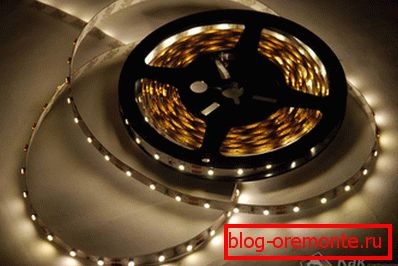
At the place of its placement, the tape is attached using an adhesive mounting layer applied to one of its surfaces. After removing the adhesive protective coating from the tape, it is necessary to attach it to the attachment point and press lightly.
Before sticking products from LEDs, it is necessary to prepare well their place of attachment, for which the mounting surface is cleaned of dirt and degreased with technical alcohol.
At the final stage of work, you should connect the LED strip built into the interior of the room to the controller, observing the polarity and order of connection specified in the diagram. The controlling controller itself is connected to the supply transformer in accordance with the above diagram.
Thus, for the arrangement of LED lighting in the room you will need to stock up on the following components:
- LED strip with a length of 10-15 m;
- an RGB controller (usually supplied with a remote control);
- wires, connectors (special connectors) and shrink tape;
- power supply transformer.

In conclusion, it should be noted that the execution of the illumination of rooms in a wide range of different colors will look much more impressive than a simple (one-color) LED lighting. This light will allow you to change at will the basic color characteristics of the illuminator (brightness and color saturation), which contributes to the creation of a festive and cozy atmosphere in the room.
Video
We offer to get acquainted with how to connect the LED strip to the controller:
A photo
